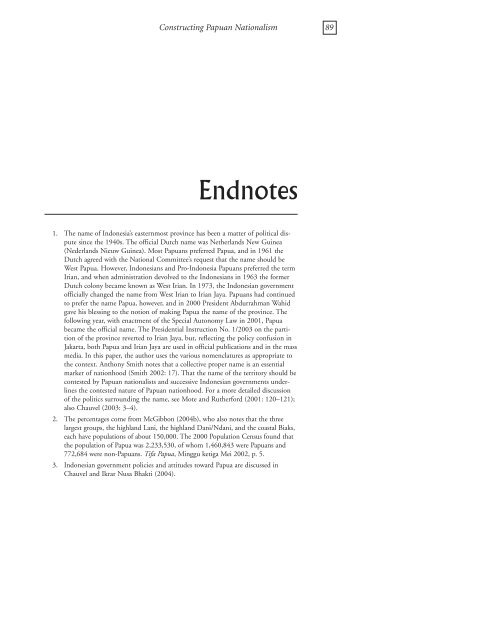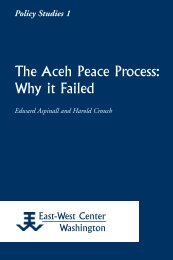Constructing Papuan Nationalism: History, Ethnicity ... - ScholarSpace
Constructing Papuan Nationalism: History, Ethnicity ... - ScholarSpace
Constructing Papuan Nationalism: History, Ethnicity ... - ScholarSpace
- No tags were found...
Create successful ePaper yourself
Turn your PDF publications into a flip-book with our unique Google optimized e-Paper software.
<strong>Constructing</strong> <strong>Papuan</strong> <strong>Nationalism</strong> 89Endnotes1. The name of Indonesia’s easternmost province has been a matter of political disputesince the 1940s. The official Dutch name was Netherlands New Guinea(Nederlands Nieuw Guinea). Most <strong>Papuan</strong>s preferred Papua, and in 1961 theDutch agreed with the National Committee’s request that the name should beWest Papua. However, Indonesians and Pro-Indonesia <strong>Papuan</strong>s preferred the termIrian, and when administration devolved to the Indonesians in 1963 the formerDutch colony became known as West Irian. In 1973, the Indonesian governmentofficially changed the name from West Irian to Irian Jaya. <strong>Papuan</strong>s had continuedto prefer the name Papua, however, and in 2000 President Abdurrahman Wahidgave his blessing to the notion of making Papua the name of the province. Thefollowing year, with enactment of the Special Autonomy Law in 2001, Papuabecame the official name. The Presidential Instruction No. 1/2003 on the partitionof the province reverted to Irian Jaya, but, reflecting the policy confusion inJakarta, both Papua and Irian Jaya are used in official publications and in the massmedia. In this paper, the author uses the various nomenclatures as appropriate tothe context. Anthony Smith notes that a collective proper name is an essentialmarker of nationhood (Smith 2002: 17). That the name of the territory should becontested by <strong>Papuan</strong> nationalists and successive Indonesian governments underlinesthe contested nature of <strong>Papuan</strong> nationhood. For a more detailed discussionof the politics surrounding the name, see Mote and Rutherford (2001: 120–121);also Chauvel (2003: 3–4).2. The percentages come from McGibbon (2004b), who also notes that the threelargest groups, the highland Lani, the highland Dani/Ndani, and the coastal Biaks,each have populations of about 150,000. The 2000 Population Census found thatthe population of Papua was 2,233,530, of whom 1,460,843 were <strong>Papuan</strong>s and772,684 were non-<strong>Papuan</strong>s. Tifa Papua, Minggu ketiga Mei 2002, p. 5.3. Indonesian government policies and attitudes toward Papua are discussed inChauvel and Ikrar Nusa Bhakti (2004).
















